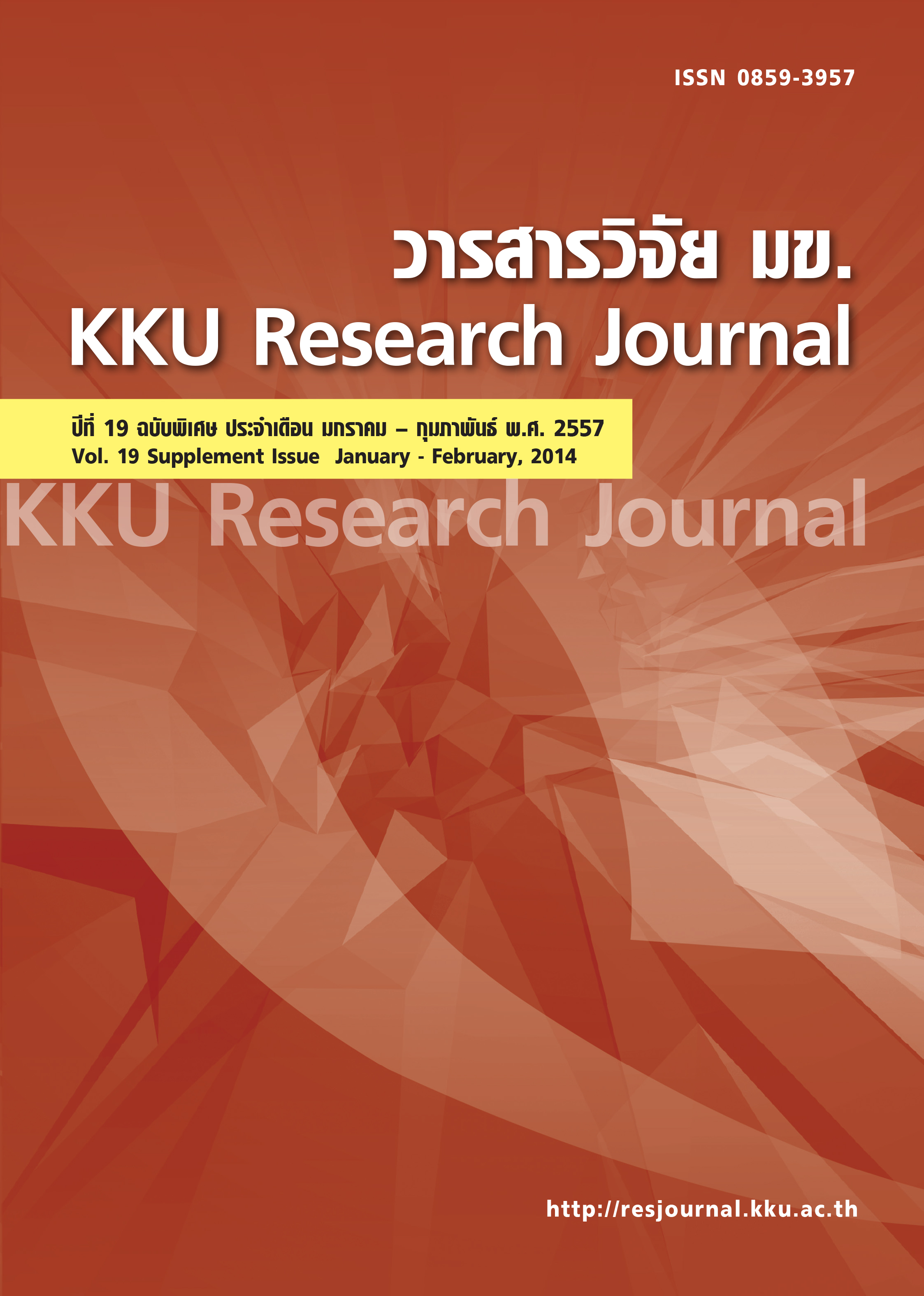Potential application of pressurized carbon dioxide for agricultural irrigation water disinfection
Main Article Content
Abstract
Irrigation water and recycled water used for farm gardens can be a potential source of contamination of microbial pathogens that cause harmful illness. This study investigated the use ofpressurized carbon dioxide to inhibit pathogens in water sources. An apparatus producing microbubbles was operated with pressure up to 0.7 MPa, room temperature and a common period for disinfection, 25 minutes. Target environmental water samples, including distilled water, artificial ground water and effluent wastewater, were subjected to microbial contamination with desired concentrations of Escherichia coli (ATCC 11303, ATCC 23631 and ATCC 13706) and bacteriophages. Under identical conditions, approxi-mately 4.0 – 5.0 log of E. coli were inactivated in water samples, whereas the reduction ratio of bacteriophages are nearly 3.0 – 4.0 log. The chemical nature of CO 2 molecule (acidification, diffusivity and solubility in water) was indicated to be the main factors causing the microorganism deaths. Besides that, high pressure, depressurization rate, characteristics of microbubbles and pumping cycle contributed to microorganism inhibition. These findings in this investigation may be considered to use carbon dioxide as a novel disinfectant to water treatment in agricultural irrigation. Moreover, carbon dioxide treatment produces no disinfection byproducts and excessive pressure after disinfection can be an advantage to enhance irrigating to plants.
Article Details
References
[2] Dillow AK, Dehghani F, Hrkach JS, Foster NR, Langer R. Bacterial inactivation by using near- and supercritical carbon dioxide. Proc. Nat Acad. Sci. USA. 1999; 96(18): 10344–10348.
[3] Enomoto A, Nakamura K, Nagai K, Hashimoto T, Hakoda M. Inactivation of food microorganisms by high-pressure carbon dioxide treatment with or without explosive decompression. Biosci. Biotechnol. Biochem. 1997; 61: 1133–1137.
[4] Feng YY, Ong SL, Hu JY, Tan XL, Ng WJ. Effects of pH and temperature on the survival of coliphages MS2 and Qโ. J. Ind. Microbiol. Biotechnol. 2003; 30: 549–552.
[5] Haas GJ, Prescott HE, Dudley E, Dik R, Hintlian C, Kean L. Inactivation of microorganisms by carbon dioxide under pressure. J. Food. Safety. 1989; 9: 253–265.
[6] Hong SI, Pyun YR. Inactivation kinetics of Lactobacillus plantarum by high pressure carbon dioxide. J. Food. Sci. 1999; 64: 728–733.
[7] Kobayashi F, Yazama F, Ikeura H, Hayata Y, Muto N, Osajima Y. Inactivation of microorganisms in untreated water by a continuous flow system with supercritical CO2 bubbling. J. Water. Environ. Technol. 2009; 7: 241–250.
[8] Lin HM, Cao NJ, Chen LF. Antimicrobial effect of pressurized carbon dioxide on Listeria monocytogenes. J. Food. Sci. 1994; 59: 657–659.
[9] Miller ES, Kutter E, Mosig G, Arisaka F, Funisawa T, Ruger W. Bacteriophage T4 genome. Microbiol . Mol. Biol. Rev. 2003; 67 (1): 86–156.
[10] Nakamura K, Enomoto A, Fukushima H, Nagai K, Hakoda M. Disruption of microbial cells by flash discharge of high pressure carbon dioxide Biosci. Biotechnol. Biochem. 1994; 58: 1297–1301.
[11] Rose JB, Gerba CP. Assessing potential health risks from viruses and parasites in reclaimed water in Arizona and Florida, USA, Water Sci. Technol. 1991; 23: 2091–2098.
[12] Vo HT, Imai T, Teeka J, Sekine M, Kanno A, Le TV, Higuchi T, Phummala K, Yamamoto K. Comparison of disinfection effect of pressurized gases of CO2, N2O, and N2 on Escherichia coli. Water. Res. 2013; 47(13): 4286–4293.
[13] Wei CI, Balaban MO, Fernando SY, Peplow AJ. Bacterial effect of high pressure CO2 treatment on foods spiked with Listeria and Salmonella. J. Food Prot. 1991; 54: 189–193.
[14] WHO. Reuse of Effluents: Methods of Wastewater Treatment and Public Health Safeguards. Report of a WHO Meeting of Experts, Technical Report Series No. 517, WHO, Geneva; 1973.
[15] You Y, Han J, Chiu PC, Jin J. Removal and inactivation of waterborne viruses using zerovalent iron. Environ. Sci. Technol. 2005; 39: 9263–9269.


